中考英语听力解题技巧课件
图片预览


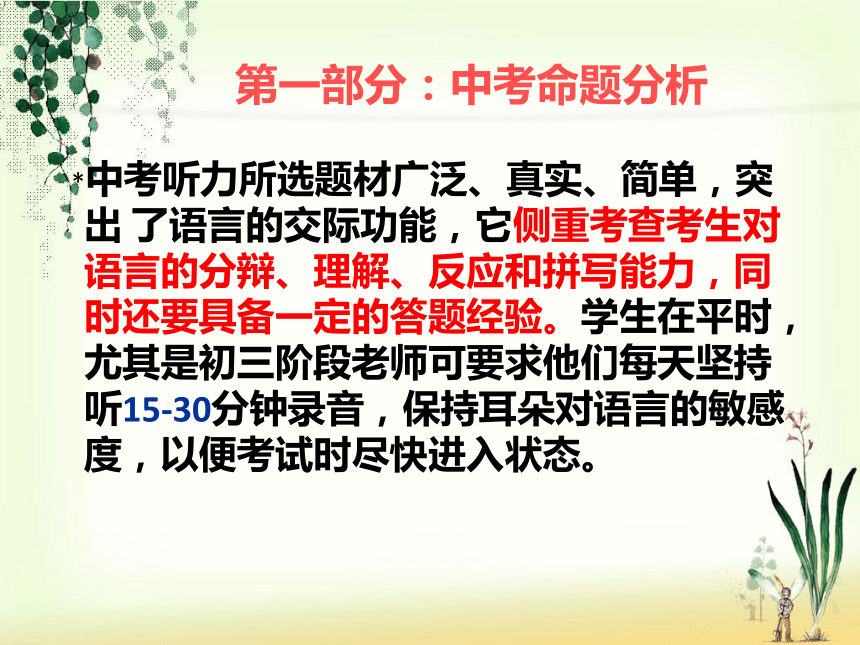
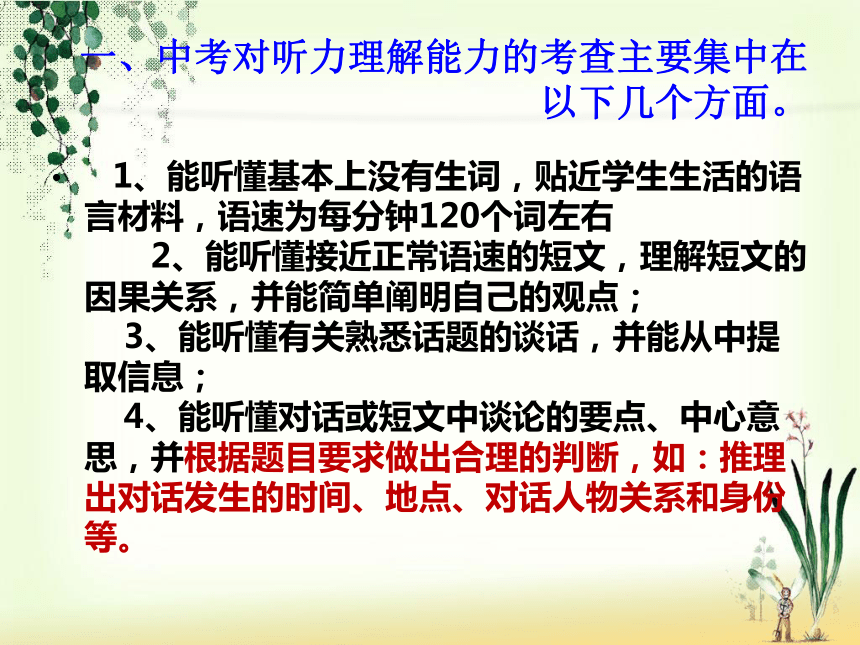
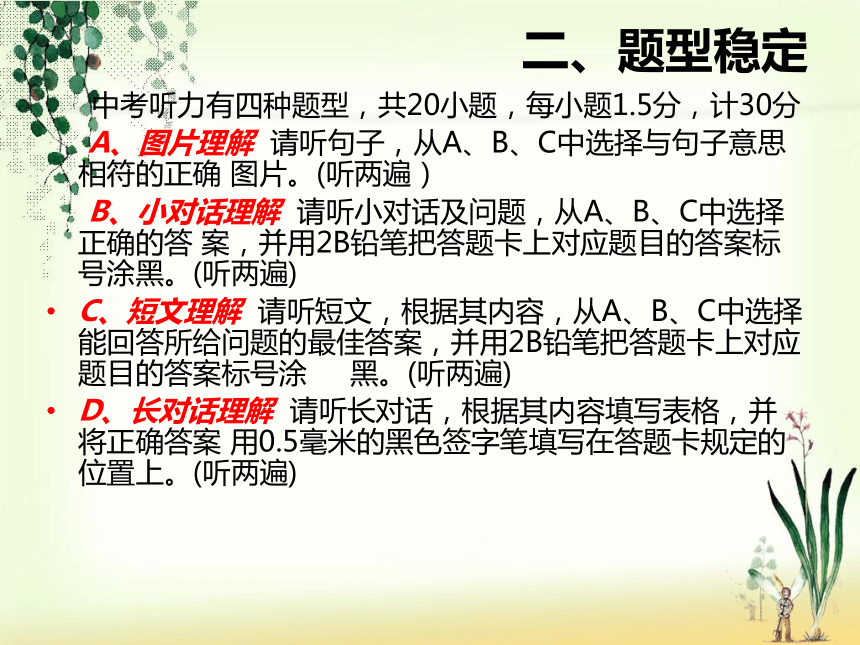

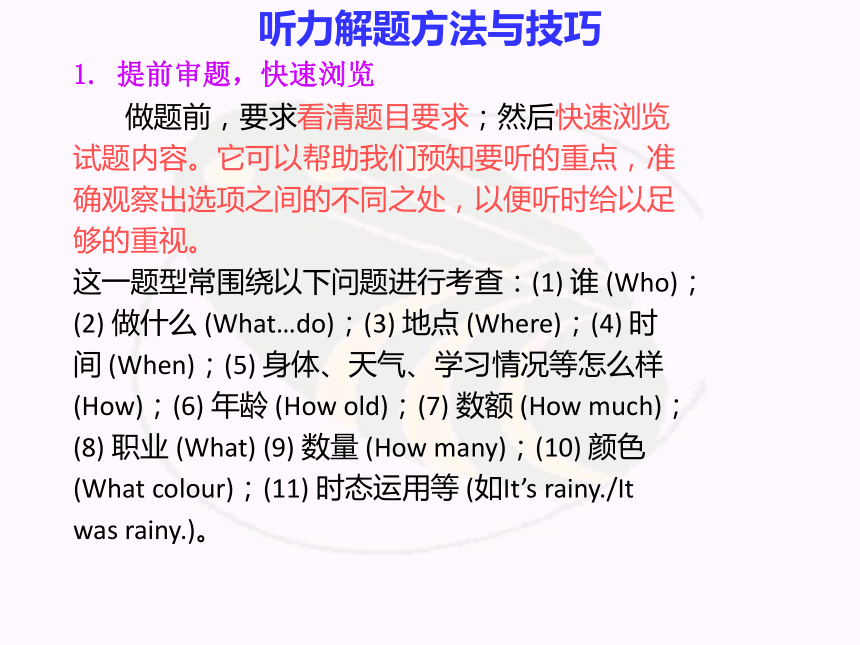

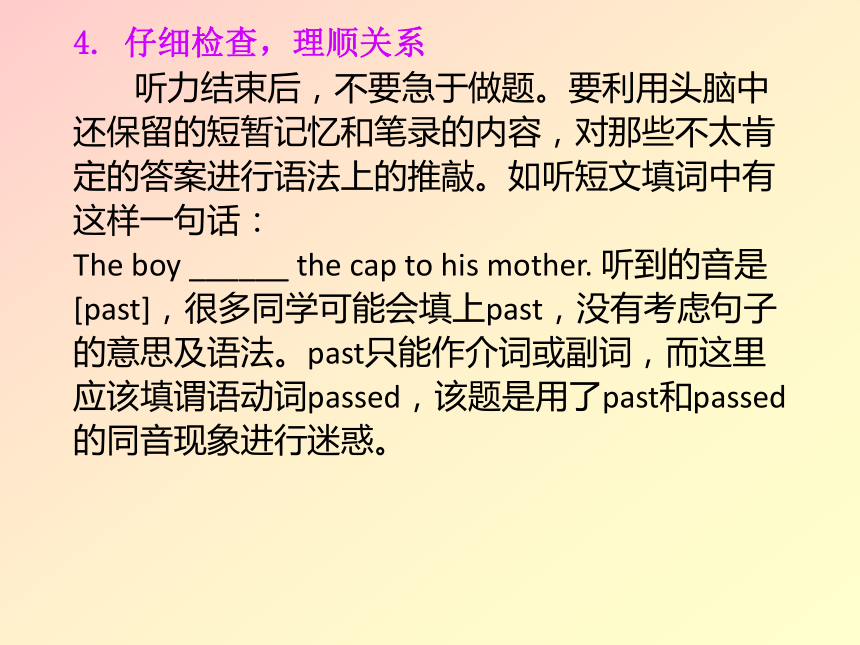
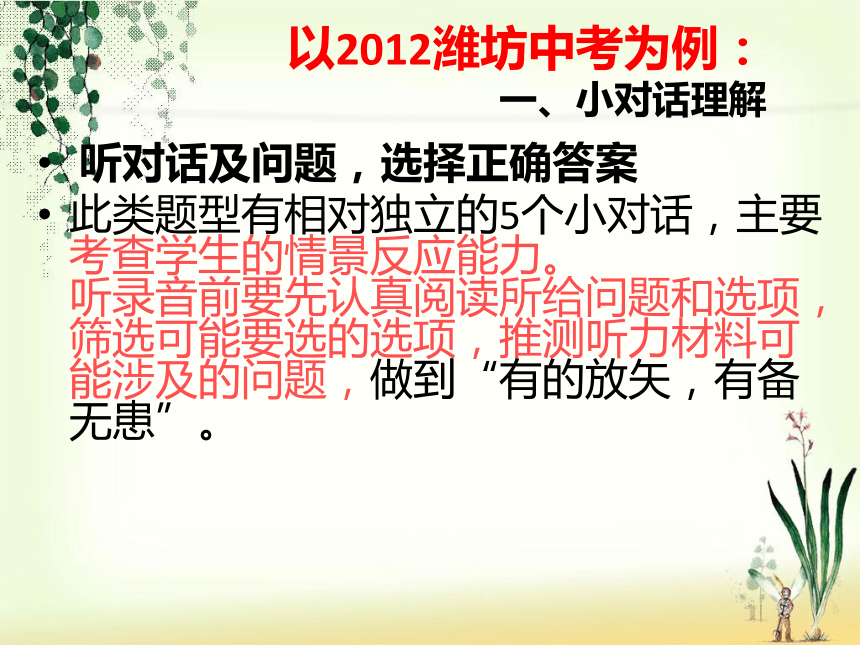


文档简介
课件30张PPT。听力部分的解题技巧 初中英语听力解题技巧1.语言基础知识的障碍;
2.母语干扰的障碍;
3.文化背景知识的障碍;
4.心理因素的障碍。听力障碍第一部分:中考命题分析 *中考听力所选题材广泛、真实、简单,突出 了语言的交际功能,它侧重考查考生对语言的分辩、理解、反应和拼写能力,同时还要具备一定的答题经验。学生在平时,尤其是初三阶段老师可要求他们每天坚持听15-30分钟录音,保持耳朵对语言的敏感度,以便考试时尽快进入状态。
一、中考对听力理解能力的考查主要集中在 以下几个方面。 1、能听懂基本上没有生词,贴近学生生活的语言材料,语速为每分钟120个词左右 2、能听懂接近正常语速的短文,理解短文的因果关系,并能简单阐明自己的观点; 3、能听懂有关熟悉话题的谈话,并能从中提取信息; 4、能听懂对话或短文中谈论的要点、中心意思,并根据题目要求做出合理的判断,如:推理出对话发生的时间、地点、对话人物关系和身份等。 二、题型稳定 中考听力有四种题型,共20小题,每小题1.5分,计30分
A、图片理解 请听句子,从A、B、C中选择与句子意思相符的正确 图片。(听两遍)
B、小对话理解 请听小对话及问题,从A、B、C中选择正确的答 案,并用2B铅笔把答题卡上对应题目的答案标号涂黑。(听两遍)
C、短文理解 请听短文,根据其内容,从A、B、C中选择能回答所给问题的最佳答案,并用2B铅笔把答题卡上对应题目的答案标号涂 黑。(听两遍)
D、长对话理解 请听长对话,根据其内容填写表格,并将正确答案 用0.5毫米的黑色签字笔填写在答题卡规定的位置上。(听两遍)
三、听力材料选择中考听力选材广泛、真实、简单,涉及家庭和朋友、学校生活、打电话、兴趣与爱好、购物、饮食、邀请、看病、健康、天气、问路、学习等话题。选材突出口语性和实用性,有强烈的生活气息和时代特色,较多的使用省略句式,同时有较多的语气信息,如停顿、犹豫、思考等,但它的句子结构不复杂,一般不会出现长句,句子语言简洁但真实。在复习阶段听力训练中,可让学生对以上提到的试题类型进行训练。
听力解题方法与技巧
1. 提前审题,快速浏览
做题前,要求看清题目要求;然后快速浏览
试题内容。它可以帮助我们预知要听的重点,准
确观察出选项之间的不同之处,以便听时给以足
够的重视。
这一题型常围绕以下问题进行考查:(1) 谁 (Who);
(2) 做什么 (What…do);(3) 地点 (Where);(4) 时
间 (When);(5) 身体、天气、学习情况等怎么样
(How);(6) 年龄 (How old);(7) 数额 (How much);
(8) 职业 (What) (9) 数量 (How many);(10) 颜色
(What colour);(11) 时态运用等 (如It’s rainy./It
was rainy.)。2. 关键词语,快速记录
在听的过程中,很多关键信息、关键词语稍
纵即逝,等到答题时又难以回忆,如年、月、日、
时刻、电话号码、人名、地名等。只有边听边及
时做好这些关键词语的记录,才能为我们答题提
供好的帮助。
3. 生词、难点,果断放弃
听力测试是有严格时间限制的,如遇到实在
听不懂的生词、难点,要果断放弃,应集中精力,
紧跟磁带速度,继续做后面的题,切不可犹豫不
决,一误再误。4. 仔细检查,理顺关系
听力结束后,不要急于做题。要利用头脑中
还保留的短暂记忆和笔录的内容,对那些不太肯
定的答案进行语法上的推敲。如听短文填词中有
这样一句话:
The boy ______ the cap to his mother. 听到的音是
[past],很多同学可能会填上past,没有考虑句子
的意思及语法。past只能作介词或副词,而这里
应该填谓语动词passed,该题是用了past和passed
的同音现象进行迷惑。以2012潍坊中考为例: 一、小对话理解 听对话及问题,选择正确答案
此类题型有相对独立的5个小对话,主要考查学生的情景反应能力。 听录音前要先认真阅读所给问题和选项,筛选可能要选的选项,推测听力材料可能涉及的问题,做到“有的放矢,有备无患”。
2012潍坊中考一、听力测试 (共20小题;每小题1分,满分20分)
(一)听句子,选择适当答语,每个句子读两遍。
1. A. Good idea! B. Thank you! C. Congratulations!
2. A. What a pity. B. Sounds nice. C. My pleasure.
3. A.He’s fine. B.He’s 16 years old. C.He’s naughty.
4. A. I’ve got a headache. B. I’ve got a friend. C. I’ve got a new bicycle.
5. A. It’s tall and thin. B. It’s 100 meters long. C. It’s next to the bookstore.
答案:(1—5 CABAC)一、听句子,选择适当答语,每个句子读两遍.
1.Hooray! We won! Our team won the game!
2.Woody can’t come to our dinner tonight because of the bad weather.
3.How old is your older brother?
4.Hello,young man.What’s wrong with you?
5.Excuse me, where’s the nearest bank here?
二、图片理解
1、认真读图和识图,能用英语表达出图片的内容。
2、仔细观察每题所给的图片内容,找出每幅图之间的相同点和不同点,预测一下录音的内容。
3、听懂句意,善于抓住关键词。
(二)听对话和问题,选择符合每个问题答案的图画,每段对话和问题读两遍。答案:(6—10 BCAAC)
二、听对话和问题,选择符合每个问题答案的图画,每段对话和问题读两遍。
6.W:Hi.Mr. Black.You look so excited.What’s up?
M:Look! I’ve just received a letter from our President.
W:Oh Cod! That’s a dream to me
Q:Why is Mr. Black so excited?
7.M:Betty,what are you doing here?
W:I’m looking for some clothes for the evening party.What do you think of my new jeans?
M:Maybe they’re not right for a party.What about your sister’s dress? I’m sure you would look
pretty in it.
W:Oh,yes.Thank you,Dad.
Q:What will the girl wear?1、抓紧听前几分钟的准备时间,先阅读本题的题干和有关选项,有些选项根据上下文逻辑关系和语法结构就可以选出,到该题录音播放时,核对一下即可。
2、听录音时把重点放在5个问题所涉及的地方,切莫一个词一个词地听,也不要听一句就翻译一句,更不必因一个词或一个短语没听懂就停步不前,要善于捕捉整体信息。 8.W:I think you’d better drive slowly here.
M:Why? The traffic is not heavy now.
W:Look at that sign,please.
M:Well,yes,I have to.
Q:Which sign are they pointing at?
9.W:How do you go to school every day? By bike?
M:I used to.But now I go to school by bus,our new school bus.
W:Really? You’re lucky.
Q:How does the boy go to school?
10.M:Excuse me,could you tell me where Ms Wang is?
W:I think she’s helping Linda with her lessons in her office.
M:No,her office is locked.
W:Let me see.Ah,yes.She’s having a talk with Lucy and her parents in the classroom.
Q.What’s Ms Wang doing now?
三、短文理解短文大多围绕who , when , where , what , how 或why来设制问题。因此,在听的时候紧紧围绕选项内容作些速记,记下关键词语,抓好前后联系,最后才能准确作出答案。短文理解是听力测试中综合性较强,难度较大的题型,主要为记叙文,有一定完整的思想内容,涉及到的词汇量较大,知识面也广,解题时应注意以下几点:
3、听的过程中注意听短文的首句和首段,它可能是短文主要内容,尾句往往是短文的结论。同时简单记录短文的时间、地点、人物和事件,有利于对全文的理解。
4、听第二遍时,注意及时核对尚未听清的选项。
(三)听对话,根据对话内容选择每个问题的最佳答案,对话和问题读两遍。
听第一段对话,回答第11、12小题。
11.Where are they?
A.At home. B.In a shop. C.In a hotel.
12.What would the man like to do?
A. To walk around. B.To buy a gift. C.To try on the shoes.
听第二段对话,回答第13、14、15小题。
13.What’s Jerry doing in the library?
A. Looking for some books. B.Writing an article. C.Watching a film.
14.When will Jerry have to finish his article?
A. On Monday. B.On Tuesday. C.On Wednesday.
15.What did Jerry decide to write about at last?
A.A book. B.A film. C.A play.
答案:(11—15 BBACB) 三、听对话,根据对话内容选择每个问题的最佳答案,对话和问题读两遍。听第一段对话,回答第11、12小题。
W:Good morning,sir.Can I help you?
M:Good morning.I'd like to choose a present for my mom.
W:We have lots of gifts for ladies.What would you like? Or what does your mom like?
M:Err…she likes walking around and chatting with our neighbors.
W:How about these walking shoes? They’re soft and comfortable.What’s her size?
M:Size? I··I don’t know.
W:It doesn’t matter,sir.You can take this pair home to let her try them on.Then if they don’t
fit well.you can come back and change them for the right pair.
M:Sounds nice.Thank you.
Q:11.Where are they?
12.What would the man like to do?听第二段对话,回答第13、14、15小题。
W:Hi,Jerry.What a busy Monday! You’re spending a lot of time in the library today. What’s up? Are you becoming a hard-working boy?
M:Hi,Polly.You’re joking.I'm thinking about my article for our school magazine New Standard.
have to finish it the day after tomorrow.The title is “my favourite book”,but I can’t decide.
what to write about.
W:Well,what’s your favorite book then?
M:It’s hard to say.In fact,I don’t really enjoy reading.
w:I see.Mmm…can you write about something else,a film,or a play,for example?
M:I don’t think so.I promised Betty,the editor,to write about a book.
W:As far as I know,Betty will be pleased if you write all article,even if it's not about a book.
M:I think you have got it right.I'll write about my favorite film instead.Thanks,Polly.
W:You’re welcome.
Q:13.What’s Jerry doing in the library?
14.When will Jerry have to finish his article?
15.What did Jerry decide to write about at last? 四,长对话理解此类题型是一段长对话,主要考查学生的情景反应能力,可从以下几点入手:
1、听录音前要先认真阅读所给出的表格,推测对话可能涉及的问题,这样可以预知要听对话的重点,以便听时给与足够的重视。
2 听录音时,要根据问题的提示,对数字、人物、时间和事件等有关信息进行简单记录。
3、从整个对话中了解对话人的“弦外之音”,把握说话者的真实含义。 近年来中考听力第四大题多以表格形式出现。请考生记住几个原则:
(1)顺序原则。出于难度因素考虑,中考听力填词通常是按顺序出题的,即考生只需按考题的顺序,一一等待并捕捉相关的信息,答题即可。
(2)语法精确原则。仍然是提醒考生不要犯语法上的小错误,如名词单复数、动词第三人称单数在一般现在时中加S等。(3)格式统一原则。考生在答题后,应注意观察表格前后,上下相关信息的格式。如动词词组是否统一用不定式形式,或动名词。名词是否需要大写,或加上相应的冠词。数字前是否需要加上No,或是价格后是否加上¥或Yuan.
(4)单词过关原则。表格题中经常要考核到考生对大纲词汇的拼写是否正确,这些词汇常包括人名、国家、国籍、职业、学科、兴趣爱好、活动、活动时间、活动地点等,对同学们的单词拼写要求是相当高的。
Interviewer:A few years ago,Dave Stirling had the idea of selling CDs over the Internet.
The business he stated from his home in Ohio,the united States of America,now sells 1
CDs a year and has made him into a millionaire at the age of 24.Dave,what’s your secret,
please?
Dave:Well,I could see that this was the 2 of shopping.Why should you pay$1 5 for a CD and spend the time going to the store and parking your car? You can get the same CD for 3 of the price by clicking on your computer.And we can find any CD you want and bring it to your 4 in 24 hours! Well,this is only the beginning.I believe that one day we’ll do our shopping over the net:it’s 5 ,quicker and cheaper.Shops and supermarkets will be a thing of the past.(四)请听一段访谈,根据访谈内容,写出所缺单词,每空一词,访谈播放两遍。
注意:听力测试结束后。请将本题答案填写在第Ⅱ卷相应的位置上。答案:(1. 500, 000 2. future 3. half 4. door 5. easier四、请听一段访谈,根据访谈内容,写出所缺单词,每空一词,访谈播放两遍。
Interviewer:A few years ago,Dave Stirling had the idea of selling CDs over the Internet. The business he started from his home in Ohio, the United States of America,now sells 500,000 CDs a year and has made him into a millionaire at the age of 24.Dave,what’s your secret,please?
Dave:Well,I could see that this Was the future of shopping.Why should you pay$15 for a CD and spend the time and the money going to the store and parking your car? You can get the same CD for half of the price by clicking on your computer.And we can find any CD you want and bring it to your door in 24 hours! Well, this is only the beginning.I believe that one day we’ll do our shopping over the net:it’s easier, quicker and cheaper.Shops and supermarkets will be a thing of the past.
听力解题方法与技巧总结
1. 提前审题,快速浏览
做题前,要求看清题目要求;然后快速浏览
试题内容。它可以帮助我们预知要听的重点,准
确观察出选项之间的不同之处,以便听时给以足
够的重视。
这一题型常围绕以下问题进行考查:(1) 谁 (Who);
(2) 做什么 (What…do);(3) 地点 (Where);(4) 时
间 (When);(5) 身体、天气、学习情况等怎么样
(How);(6) 年龄 (How old);(7) 数额 (How much);
(8) 职业 (What) (9) 数量 (How many);(10) 颜色
(What colour);(11) 时态运用等 (如It’s rainy./It
was rainy.)。每天在特定的30分钟之内做一套听力模拟题目,要限时,限速,限量;
考前每天听半小时左右,听的时候投入,完全模拟考试情景。这样坚持下来,进步不属于你还会属于谁呢?建议
2.母语干扰的障碍;
3.文化背景知识的障碍;
4.心理因素的障碍。听力障碍第一部分:中考命题分析 *中考听力所选题材广泛、真实、简单,突出 了语言的交际功能,它侧重考查考生对语言的分辩、理解、反应和拼写能力,同时还要具备一定的答题经验。学生在平时,尤其是初三阶段老师可要求他们每天坚持听15-30分钟录音,保持耳朵对语言的敏感度,以便考试时尽快进入状态。
一、中考对听力理解能力的考查主要集中在 以下几个方面。 1、能听懂基本上没有生词,贴近学生生活的语言材料,语速为每分钟120个词左右 2、能听懂接近正常语速的短文,理解短文的因果关系,并能简单阐明自己的观点; 3、能听懂有关熟悉话题的谈话,并能从中提取信息; 4、能听懂对话或短文中谈论的要点、中心意思,并根据题目要求做出合理的判断,如:推理出对话发生的时间、地点、对话人物关系和身份等。 二、题型稳定 中考听力有四种题型,共20小题,每小题1.5分,计30分
A、图片理解 请听句子,从A、B、C中选择与句子意思相符的正确 图片。(听两遍)
B、小对话理解 请听小对话及问题,从A、B、C中选择正确的答 案,并用2B铅笔把答题卡上对应题目的答案标号涂黑。(听两遍)
C、短文理解 请听短文,根据其内容,从A、B、C中选择能回答所给问题的最佳答案,并用2B铅笔把答题卡上对应题目的答案标号涂 黑。(听两遍)
D、长对话理解 请听长对话,根据其内容填写表格,并将正确答案 用0.5毫米的黑色签字笔填写在答题卡规定的位置上。(听两遍)
三、听力材料选择中考听力选材广泛、真实、简单,涉及家庭和朋友、学校生活、打电话、兴趣与爱好、购物、饮食、邀请、看病、健康、天气、问路、学习等话题。选材突出口语性和实用性,有强烈的生活气息和时代特色,较多的使用省略句式,同时有较多的语气信息,如停顿、犹豫、思考等,但它的句子结构不复杂,一般不会出现长句,句子语言简洁但真实。在复习阶段听力训练中,可让学生对以上提到的试题类型进行训练。
听力解题方法与技巧
1. 提前审题,快速浏览
做题前,要求看清题目要求;然后快速浏览
试题内容。它可以帮助我们预知要听的重点,准
确观察出选项之间的不同之处,以便听时给以足
够的重视。
这一题型常围绕以下问题进行考查:(1) 谁 (Who);
(2) 做什么 (What…do);(3) 地点 (Where);(4) 时
间 (When);(5) 身体、天气、学习情况等怎么样
(How);(6) 年龄 (How old);(7) 数额 (How much);
(8) 职业 (What) (9) 数量 (How many);(10) 颜色
(What colour);(11) 时态运用等 (如It’s rainy./It
was rainy.)。2. 关键词语,快速记录
在听的过程中,很多关键信息、关键词语稍
纵即逝,等到答题时又难以回忆,如年、月、日、
时刻、电话号码、人名、地名等。只有边听边及
时做好这些关键词语的记录,才能为我们答题提
供好的帮助。
3. 生词、难点,果断放弃
听力测试是有严格时间限制的,如遇到实在
听不懂的生词、难点,要果断放弃,应集中精力,
紧跟磁带速度,继续做后面的题,切不可犹豫不
决,一误再误。4. 仔细检查,理顺关系
听力结束后,不要急于做题。要利用头脑中
还保留的短暂记忆和笔录的内容,对那些不太肯
定的答案进行语法上的推敲。如听短文填词中有
这样一句话:
The boy ______ the cap to his mother. 听到的音是
[past],很多同学可能会填上past,没有考虑句子
的意思及语法。past只能作介词或副词,而这里
应该填谓语动词passed,该题是用了past和passed
的同音现象进行迷惑。以2012潍坊中考为例: 一、小对话理解 听对话及问题,选择正确答案
此类题型有相对独立的5个小对话,主要考查学生的情景反应能力。 听录音前要先认真阅读所给问题和选项,筛选可能要选的选项,推测听力材料可能涉及的问题,做到“有的放矢,有备无患”。
2012潍坊中考一、听力测试 (共20小题;每小题1分,满分20分)
(一)听句子,选择适当答语,每个句子读两遍。
1. A. Good idea! B. Thank you! C. Congratulations!
2. A. What a pity. B. Sounds nice. C. My pleasure.
3. A.He’s fine. B.He’s 16 years old. C.He’s naughty.
4. A. I’ve got a headache. B. I’ve got a friend. C. I’ve got a new bicycle.
5. A. It’s tall and thin. B. It’s 100 meters long. C. It’s next to the bookstore.
答案:(1—5 CABAC)一、听句子,选择适当答语,每个句子读两遍.
1.Hooray! We won! Our team won the game!
2.Woody can’t come to our dinner tonight because of the bad weather.
3.How old is your older brother?
4.Hello,young man.What’s wrong with you?
5.Excuse me, where’s the nearest bank here?
二、图片理解
1、认真读图和识图,能用英语表达出图片的内容。
2、仔细观察每题所给的图片内容,找出每幅图之间的相同点和不同点,预测一下录音的内容。
3、听懂句意,善于抓住关键词。
(二)听对话和问题,选择符合每个问题答案的图画,每段对话和问题读两遍。答案:(6—10 BCAAC)
二、听对话和问题,选择符合每个问题答案的图画,每段对话和问题读两遍。
6.W:Hi.Mr. Black.You look so excited.What’s up?
M:Look! I’ve just received a letter from our President.
W:Oh Cod! That’s a dream to me
Q:Why is Mr. Black so excited?
7.M:Betty,what are you doing here?
W:I’m looking for some clothes for the evening party.What do you think of my new jeans?
M:Maybe they’re not right for a party.What about your sister’s dress? I’m sure you would look
pretty in it.
W:Oh,yes.Thank you,Dad.
Q:What will the girl wear?1、抓紧听前几分钟的准备时间,先阅读本题的题干和有关选项,有些选项根据上下文逻辑关系和语法结构就可以选出,到该题录音播放时,核对一下即可。
2、听录音时把重点放在5个问题所涉及的地方,切莫一个词一个词地听,也不要听一句就翻译一句,更不必因一个词或一个短语没听懂就停步不前,要善于捕捉整体信息。 8.W:I think you’d better drive slowly here.
M:Why? The traffic is not heavy now.
W:Look at that sign,please.
M:Well,yes,I have to.
Q:Which sign are they pointing at?
9.W:How do you go to school every day? By bike?
M:I used to.But now I go to school by bus,our new school bus.
W:Really? You’re lucky.
Q:How does the boy go to school?
10.M:Excuse me,could you tell me where Ms Wang is?
W:I think she’s helping Linda with her lessons in her office.
M:No,her office is locked.
W:Let me see.Ah,yes.She’s having a talk with Lucy and her parents in the classroom.
Q.What’s Ms Wang doing now?
三、短文理解短文大多围绕who , when , where , what , how 或why来设制问题。因此,在听的时候紧紧围绕选项内容作些速记,记下关键词语,抓好前后联系,最后才能准确作出答案。短文理解是听力测试中综合性较强,难度较大的题型,主要为记叙文,有一定完整的思想内容,涉及到的词汇量较大,知识面也广,解题时应注意以下几点:
3、听的过程中注意听短文的首句和首段,它可能是短文主要内容,尾句往往是短文的结论。同时简单记录短文的时间、地点、人物和事件,有利于对全文的理解。
4、听第二遍时,注意及时核对尚未听清的选项。
(三)听对话,根据对话内容选择每个问题的最佳答案,对话和问题读两遍。
听第一段对话,回答第11、12小题。
11.Where are they?
A.At home. B.In a shop. C.In a hotel.
12.What would the man like to do?
A. To walk around. B.To buy a gift. C.To try on the shoes.
听第二段对话,回答第13、14、15小题。
13.What’s Jerry doing in the library?
A. Looking for some books. B.Writing an article. C.Watching a film.
14.When will Jerry have to finish his article?
A. On Monday. B.On Tuesday. C.On Wednesday.
15.What did Jerry decide to write about at last?
A.A book. B.A film. C.A play.
答案:(11—15 BBACB) 三、听对话,根据对话内容选择每个问题的最佳答案,对话和问题读两遍。听第一段对话,回答第11、12小题。
W:Good morning,sir.Can I help you?
M:Good morning.I'd like to choose a present for my mom.
W:We have lots of gifts for ladies.What would you like? Or what does your mom like?
M:Err…she likes walking around and chatting with our neighbors.
W:How about these walking shoes? They’re soft and comfortable.What’s her size?
M:Size? I··I don’t know.
W:It doesn’t matter,sir.You can take this pair home to let her try them on.Then if they don’t
fit well.you can come back and change them for the right pair.
M:Sounds nice.Thank you.
Q:11.Where are they?
12.What would the man like to do?听第二段对话,回答第13、14、15小题。
W:Hi,Jerry.What a busy Monday! You’re spending a lot of time in the library today. What’s up? Are you becoming a hard-working boy?
M:Hi,Polly.You’re joking.I'm thinking about my article for our school magazine New Standard.
have to finish it the day after tomorrow.The title is “my favourite book”,but I can’t decide.
what to write about.
W:Well,what’s your favorite book then?
M:It’s hard to say.In fact,I don’t really enjoy reading.
w:I see.Mmm…can you write about something else,a film,or a play,for example?
M:I don’t think so.I promised Betty,the editor,to write about a book.
W:As far as I know,Betty will be pleased if you write all article,even if it's not about a book.
M:I think you have got it right.I'll write about my favorite film instead.Thanks,Polly.
W:You’re welcome.
Q:13.What’s Jerry doing in the library?
14.When will Jerry have to finish his article?
15.What did Jerry decide to write about at last? 四,长对话理解此类题型是一段长对话,主要考查学生的情景反应能力,可从以下几点入手:
1、听录音前要先认真阅读所给出的表格,推测对话可能涉及的问题,这样可以预知要听对话的重点,以便听时给与足够的重视。
2 听录音时,要根据问题的提示,对数字、人物、时间和事件等有关信息进行简单记录。
3、从整个对话中了解对话人的“弦外之音”,把握说话者的真实含义。 近年来中考听力第四大题多以表格形式出现。请考生记住几个原则:
(1)顺序原则。出于难度因素考虑,中考听力填词通常是按顺序出题的,即考生只需按考题的顺序,一一等待并捕捉相关的信息,答题即可。
(2)语法精确原则。仍然是提醒考生不要犯语法上的小错误,如名词单复数、动词第三人称单数在一般现在时中加S等。(3)格式统一原则。考生在答题后,应注意观察表格前后,上下相关信息的格式。如动词词组是否统一用不定式形式,或动名词。名词是否需要大写,或加上相应的冠词。数字前是否需要加上No,或是价格后是否加上¥或Yuan.
(4)单词过关原则。表格题中经常要考核到考生对大纲词汇的拼写是否正确,这些词汇常包括人名、国家、国籍、职业、学科、兴趣爱好、活动、活动时间、活动地点等,对同学们的单词拼写要求是相当高的。
Interviewer:A few years ago,Dave Stirling had the idea of selling CDs over the Internet.
The business he stated from his home in Ohio,the united States of America,now sells 1
CDs a year and has made him into a millionaire at the age of 24.Dave,what’s your secret,
please?
Dave:Well,I could see that this was the 2 of shopping.Why should you pay$1 5 for a CD and spend the time going to the store and parking your car? You can get the same CD for 3 of the price by clicking on your computer.And we can find any CD you want and bring it to your 4 in 24 hours! Well,this is only the beginning.I believe that one day we’ll do our shopping over the net:it’s 5 ,quicker and cheaper.Shops and supermarkets will be a thing of the past.(四)请听一段访谈,根据访谈内容,写出所缺单词,每空一词,访谈播放两遍。
注意:听力测试结束后。请将本题答案填写在第Ⅱ卷相应的位置上。答案:(1. 500, 000 2. future 3. half 4. door 5. easier四、请听一段访谈,根据访谈内容,写出所缺单词,每空一词,访谈播放两遍。
Interviewer:A few years ago,Dave Stirling had the idea of selling CDs over the Internet. The business he started from his home in Ohio, the United States of America,now sells 500,000 CDs a year and has made him into a millionaire at the age of 24.Dave,what’s your secret,please?
Dave:Well,I could see that this Was the future of shopping.Why should you pay$15 for a CD and spend the time and the money going to the store and parking your car? You can get the same CD for half of the price by clicking on your computer.And we can find any CD you want and bring it to your door in 24 hours! Well, this is only the beginning.I believe that one day we’ll do our shopping over the net:it’s easier, quicker and cheaper.Shops and supermarkets will be a thing of the past.
听力解题方法与技巧总结
1. 提前审题,快速浏览
做题前,要求看清题目要求;然后快速浏览
试题内容。它可以帮助我们预知要听的重点,准
确观察出选项之间的不同之处,以便听时给以足
够的重视。
这一题型常围绕以下问题进行考查:(1) 谁 (Who);
(2) 做什么 (What…do);(3) 地点 (Where);(4) 时
间 (When);(5) 身体、天气、学习情况等怎么样
(How);(6) 年龄 (How old);(7) 数额 (How much);
(8) 职业 (What) (9) 数量 (How many);(10) 颜色
(What colour);(11) 时态运用等 (如It’s rainy./It
was rainy.)。每天在特定的30分钟之内做一套听力模拟题目,要限时,限速,限量;
考前每天听半小时左右,听的时候投入,完全模拟考试情景。这样坚持下来,进步不属于你还会属于谁呢?建议
同课章节目录
- 词法
- 名词
- 动词和动词短语
- 动词语态
- 动词时态
- 助动词和情态动词
- 非谓语动词
- 冠词
- 代词
- 数词和量词
- 形容词副词及其比较等级
- 介词和介词短语
- 连词和感叹词
- 构词法
- 相似、相近词比较
- 句法
- 陈述句
- 一般疑问句和否定疑问句
- 特殊疑问句及选择疑问句
- 反意疑问句
- 存在句(There be句型)
- 宾语从句
- 定语从句
- 状语从句
- 主谓一致问题
- 简单句
- 并列句
- 复合句
- 主谓一致
- 主、表语从句
- 名词性从句
- 直接引语和间接引语
- 虚拟语气
- 感叹句
- 强调句
- 倒装句
- 祈使句
- 句子的成分
- 句子的分类
- 题型专区
- 单项选择部分
- 易错题
- 完形填空
- 阅读理解
- 词汇练习
- 听说训练
- 句型转换
- 补全对话
- 短文改错
- 翻译
- 书面表达
- 任务型阅读
- 语法填空
- 其他资料
